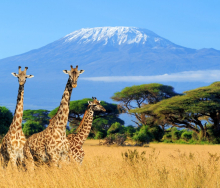FOLLOWING the "most devastating floods in the history of the Kruger National Park since its opening in 1927", life in the park has pretty much returned to normal, reports Dr Salifou Siddou, head of corporate affairs at the South African National Parks (SANP).
"Most of the damage to the infrastructure has been repaired, with a high priority having been placed on restoring access and essential services."
High-level bridges over the Sabie River (Kruger Gate and between Skukuza and Satara) have been repaired and the Skukuza restcamp is now fully operational.
All camps in the area are operational, with the exception of some of the smaller bush camps ie: Biyamiti, Jakkalsbessie, Shimuwini, Boulders, Balule and Roodewal.
The Crocodile River Bridge gate is still closed as the causeway remains submerged and the low water bridge on road H14 remains closed until further notice, although the north level bridge across the Letaba River has reopened.
The SANP recommends that visitors to the south of the park use the Malelane gate to enter the park as the Hazyview road is full of potholes. The Pafuri Gate in the northwest corner of the park opened last Thursday, March 30.
The tar road linking Phalaborwa to Mopani is still closed due to serious damage to the Letaba low level bridge. Guests should travel via the Letaba camp, advises Siddou.
While some of the animals, such as lion, giraffe and elephants are behaving rather "strangely" by congregating on the tar roads, apparently to avoid the mud as the heavyweights such as bull elephants tend to get stuck, the rangers are keeping detailed records of the effects of the floods so that the full impact can be documented.
"As nature operates in cycles, the chances of the same scenario occurring are very high," says Siddou.
According to him, there is keen public interest in visiting the Kruger 'after the floods' to view the extensive damage and the changed landscapes of the areas adjacent to the Sabie River.
"The heavy rains have been a boom for the natural environment, having cleared the waterways of years of silting resulting from damming and having cleared away the build-up of dense vegetation along the rivers."
Invasive alien plants such as lantana and water cabbage have also washed away.
Siddou says in places where the water has receded it looks as though a giant mower has moved along the rivers, uprooting trees and covering them with soggy vegetation.
"But already there are signs of new growth on banks and islands."
Rangers says now is the best time to view game such as impala, blue wildebeest and zebra as they do not fancy tall grass and also tend to hang around the roads.
(Adele Mackenzie)













